Motion Sensitive Camera
Fall, 2011
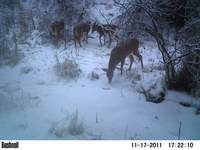
As a test of our motion sensitive camera we set up at a convenient place
by the creek.
The most common animals caught by the camera were deer and coyotes,
but we did get some pictures of our neighbor's cows
(we assume they found their way home).
Here,
four White-tail deer shelter next to the frozen creek.
At least one of these appears to be a first-year fawn.
The haze at left is from the relatively warm water in the creek;
the air temperature here was close to 0°F.

There were not many interesting pictures until we placed the remains of
a deer our friend shot in the view.
We were hoping to get a picture of a mountain lion,
but most visitors were magpies and crows.
Finally,
a
Rough-Legged Hawk
chased off the other birds and stood his ground when a White-tail buck
wandered by.
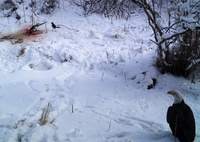
By morning the next day,
most of the remains were gone,
eaten by the magpies and crows.
A Bald Eagle dropped by to check out the situation.
The magpies are hoping the eagle does not chase them off.
The eagle must have had better prospects elsewhere and did not stay
long.
The camera takes a picture every second.
If there is little or no movement,
it may not take a picture;
if the movement is very fast,
it may miss the action.
This accounts for the jerky nature of the video we made from the
pictures and the instant disappearance of the eagle at the end.
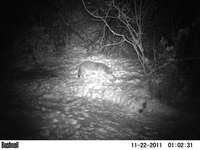
Of course,
a coyote had to slink by in the night.
This is an example of the camera's infrared flash.
We're pretty confident of the settings for the camera now so we will be
moving it to another location to see if we can get more interesting
photos.
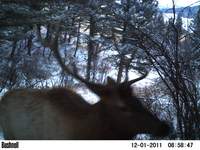
Ken shot a White-tail doe and buck,
but passed up an opportunity at a 6x6 bull elk.
We didn't see any more elk until a few days after hunting season was
over.
Gary spooked a big herd while plowing and the camera got many pictures of
stampeding elk,
including this 4x4 bull.
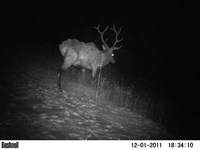
In the early evening of the same day,
a 5x5 bull wandered by.
This guy looks a little ragged compared to the typical over-fed elk we
normally see.
Note:
the times on these photos are still on daylight saving time,
so add an hour to get Mountain Standard Time.
One of these days I will get around to adjusting the time.





